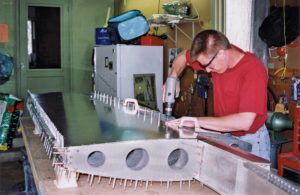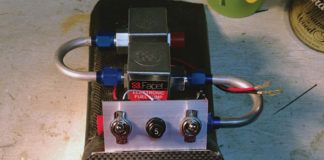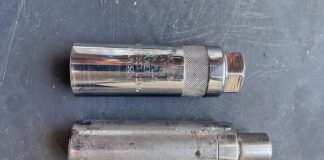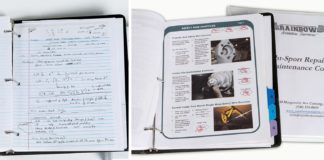
The judges at AirVenture 2006 concluded that I had created a Plans Built Champion and, as such, presented me with a sculpture of Charles Lindbergh. I didn’t set out to build an award-winning airplane, but after I did people wanted to know how to duplicate my experience. “What band saw did you use?” was one question. I was also asked to identify the best workshop size, polisher, drill, air compressor—you get the idea. These questions are also asked within the builder communities of other kit designs. “What is the best iron for shrinking fabric?” “What is the best welder?” If I may be so bold, I’ll share with you my workshop and tool secrets. These admissions may be why no companies offered me the opportunity to champion their products.
The Best Shop
It began here. On one side of my two-car garage, I placed a 4×8-foot workbench, built from 2x4s and particle board, on two sawhorses. It wasn’t centered under the single fluorescent light that hung from the ceiling—a refrigerator prevented that—but it was nearish the only window in the garage. In the summer, I kept myself comfortable by ending evening work sessions or closing the garage door when the mosquitoes got hungry. In the winter, I heated my work area with a kerosene-fueled torpedo heater that was given to me. Free is always the best. I only needed to make it work. It kept me warm (enough) until the garage door opened to let the family car in or out. The open door, however, facilitated the exchange of stale, carbon monoxide-saturated air for fresh air, which may be why I’m still here to share this with you. What made my shop the best was that I used space I already had, and it was attached to my house, which kept the project close and kept me engaged in building.
The Best Tools
Scratch-building an aluminum airframe requires fewer tools than you’d think, but two you can’t do without are a drill press and a band saw. And I had the best. When the weather was good, the drill press (a floor model, brand unknown) and the band saw (a 9-inch tabletop, by Craftsman) were 152 steps from my project, in my neighbor’s hangar. The walk took 1 minute, 27 seconds each way. (I paced it and timed it, in the interest of accuracy.) Those tools were almost twice as far in the winter, when I had to walk the plowed street and driveways rather than cut through a woods that stood between me and them. The shear and bending brake I used were in the Sonex hangar (2 miles from my home), where I didn’t yet work but where I did spend one hour of each 30-minute lunch break. I used my employer’s arbor press when the need to bend a thick fitting arose. Those tools were the best because I didn’t have to buy them or find space for them in my garage.
A Sonex is held together with 10,000 stainless-steel pulled rivets. In theory, I could have riveted it together with a $9 manual rivet gun, but that would have led to an abnormally large forearm and permanent damage to my right hand. But also an impressive handshake. I opted for a $30 pneumatic riveter from a national tool chain rather than a nearly identical unit for $150 from an aircraft supply house. The riveter would have been $30 wasted without an air compressor to operate it. Fate brought a retiring house painter’s 20-gallon air compressor to my doorstep. It wasn’t quite the best; I had to pay $50 for it, and on really cold days it would pop a circuit breaker when its motor tried to turn against the piston’s thick oil. I resolved that problem by preheating it with my kerosene heater.
When I began polishing the airframe, I did the initial cutting with a $39 rotary buffer from the same national tool chain where I purchased the riveter. It handled the job well. Because I wasn’t spending big dollars on paint, I splurged on the equipment for the final phase of polishing by purchasing the cast-aluminum, dual-head orbital polisher “everyone” agreed was the best for vintage campers and classic aircraft. I found it heavy and awkward and, at $300, expensive. I sold it and replaced it with a 6-inch orbital buffer ($21) from a big box store’s automotive department. The smaller buffer was much easier to handle, and I feel it improved my polishing results. The on/off switch on the barely used dual-head polisher broke the day I sold it. The 6-inch buffer celebrated its 15th birthday this year. I still use it.
Your Best Is the Best that Matters
What is “the best”? How is that defined, and by whom? Is it the most expensive? Or the most popular, which usually has more to do with marketing than quality? Is it the brands that have a cult-like following? No. The best tools are the ones that fit your budget, your needs and facilitate you to do your best work. If you can properly deburr the edge of an aluminum rib with a kitchen knife, then a kitchen knife is the best tool for you. Expensive tools do not guarantee good workmanship, though inexpensive tools are no excuse for poor workmanship. To be sure, “inexpensive” and “poor quality” are different. Even the most expensive screwdriver should not be used on your project if it has been reduced to “poor quality” by prying paint cans open or perforating the lid of a butterfly jar. It will also be hard to coax your best work out of a dull band saw blade or a drill press with a wobbling chuck.
The only “best” that matters is that you do your best. That hinges more on your approach to building than it does your tools and workspace.














Couldn’t agree more. Many times in my life I’ve had to make do with what little I had at my disposal. Strangely, nearly all of my best work in my life was always done in a pinch without access to “the right tools”. Attempts to replicate that work later with “proper tools”, somehow always resulted in an inferior finished end result compared to the one I did without thinking about it being perfect and just making do so that it would work well enough.
It’s rarely the quality of the tool itself. If you have a sharp drill bit, what difference does it make which brand of drill is spinning it at the appropriate speed? If you’re using a deburr wheel, the aluminum wont know nor care what brand of tool was behind the abrasive disk. It’s all how you use it.
In my experience, it really comes down to personal self discipline, and meticulous attention to detail where it matters most.
I too use many such low cost tools as well, as not everything low cost is “cheap”, and not everything expensive is worth the cost. It sounds like I probably even have many of the same brands/models as mentioned in the article. I take care of my tools, and that helps make even low cost tools last far longer than people claim they should last. Almost every tool or machine I own ends up outlasting any offered warranties about 3x over or longer, hence why I Never pay for warranties, nor care if a company offers a warranty. Take care of your stuff, maintain them, and don’t use them in ways they were never intended, and they’ll last a very long time.